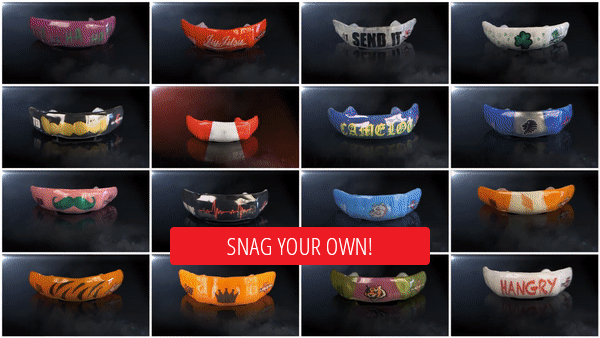How To Avoid Gagging On Dry Turkey (And Your Mouthguard)

As you prepare for Thanksgiving, make sure you take extra special care of your turkey. One of the main complaints about a Thanksgiving meal is that the turkey is too dry or the cut is too lean.
That’s why the Thanksgiving turkey is so much like your mouthguard. One of the main complaints that athletes have about mouthguards is that they’re uncomfortable, and oftentimes, make them gag. It is also important to check the fit of your mouthguard for proper protection.
But, to put it simply: when a mouthguard makes a player gag, something is wrong with the mouthguard. (Your turkey, well, we can’t speak to that.)
A common myth about mouthguards is that they need to completely cover all of the upper teeth. That is actually false. Gagging is typically caused by mouthguards that have too much material, especially where it doesn’t need to be.
Mouthguards need to be cut properly — like a Thanksgiving turkey. In order to keep from gagging, the material must avoid the soft palate — the fleshy, flexible part toward the back of the roof of the mouth. That means your mouthguard must end between the end of the first molar and midway through the second.
Any protective material in the soft palate area is providing no protection from any injury, so no material should enter this area from your mouthguard to avoid any discomfort.
And no need to worry — a mouthguard cut properly actually provides better protection, as too much material towards the molars makes the mouthguard more uncomfortable while providing minimal amounts of additional protection. It also means you can breathe, communicate and hydrate without needing to remove your mouthguard.
Much like the cut of the turkey, the level of moisture makes all the difference, as you never want your turkey to be too dry. Well, the same goes for the thickness of the material used for the mouthguard. It’s important to maintain proper thickness for protection but anything beyond that could cause uncomfortable gagging.
That material also makes it difficult to open and close the mouth. Mouthguards should fit snug against the upper teeth, without needing to bite or clench. This means your mouthguard is where it’s needed when impact occurs.
While this may vary from sport to sport, with some sports requiring more protection than others, all mouthguards should have at least 4mm thickness of material in the important impact zones — the areas in front of the teeth and under the molars.
When material is too thick, it may leave the mouth to far open causing issues with proper breathing and swallowing. And that also affects the gag reflex.
Like a perfectly cooked turkey, only a custom mouthguard is engineered for such an intimate fit.
What do a Thanksgiving turkey and a mouthguard have in common? Find out with an expertly cut Gladiator custom mouthguard with all the fixin’s. Learn more at the link below.
Expertly Cut With All The Fixin’s






